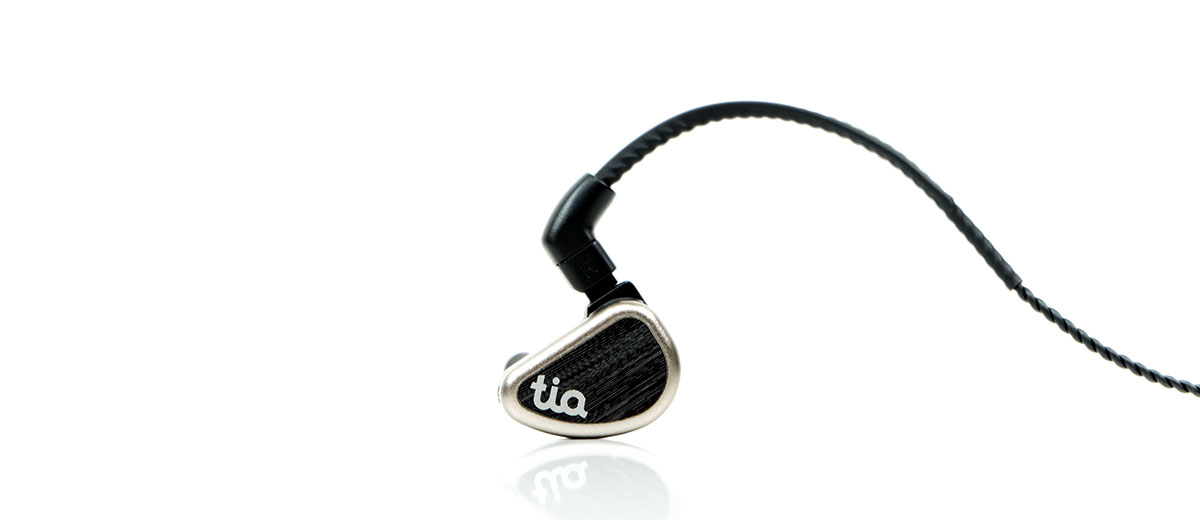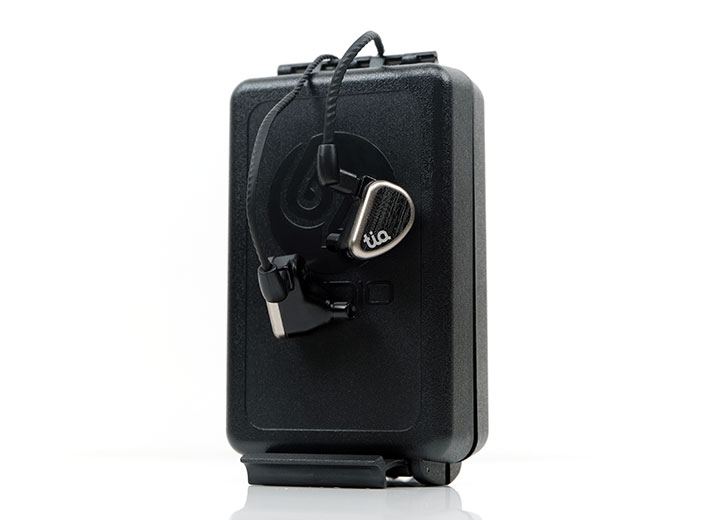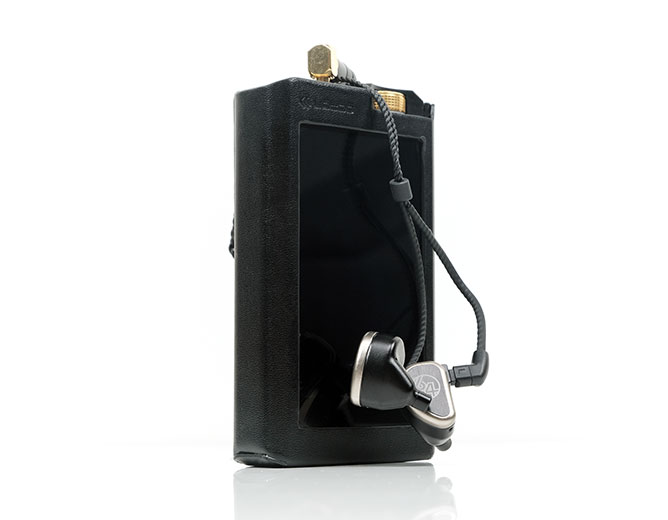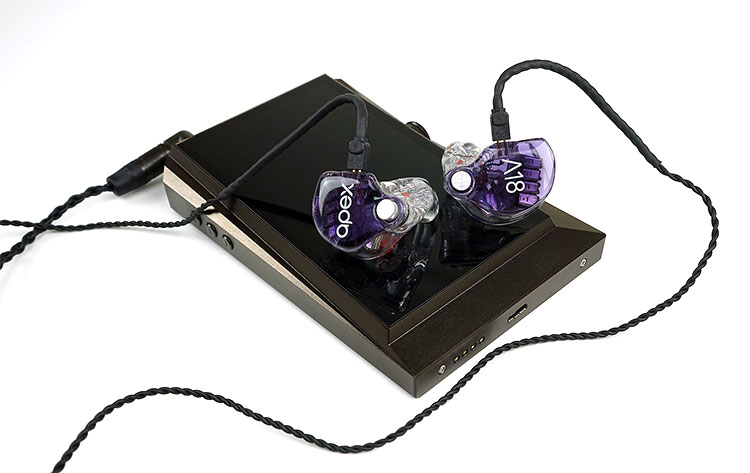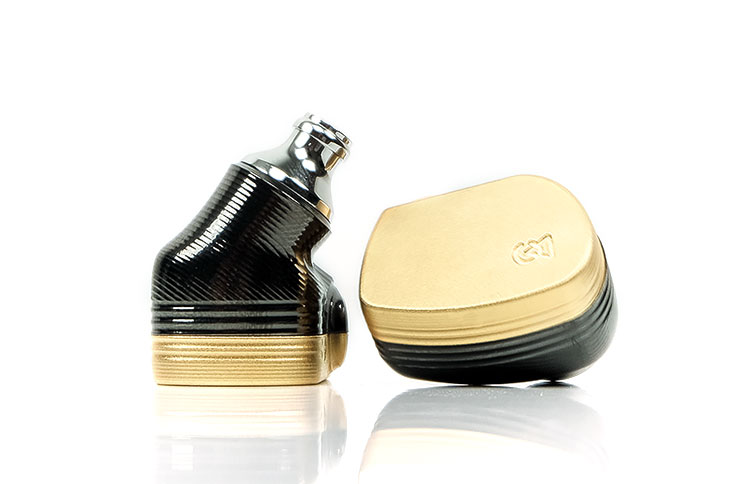Sound Impressions
Summary
There was this sound I heard a few years ago from a prototype of the Fourté during CanJam 2017. A sound that was quite different from the final version I am told. I could not get it out of my mind and often wondered if they would bring this fabulously musical and natural tuning back. Well, to some extent I think they did with the tia Trio™.
Of course, the sound is unmistakably a hybrid sound with that deep and voluminous dynamic driver delivery but there is so much more to the tia Trio™ than that.
To call it a W-shaped tuning would also be somewhat of a glib statement. There is a very high level of refinement and detail in the tia Trio™’s performance to go alongside a high-contrast yet somehow very smooth and inviting tone.
Yes, the upper treble is forward and sparkling, and yes, the vocal presence is engaging; two elements that balance very nicely with that impactful and very deep sounding 10mm dynamic driver. However, what draws you in with the tia Trio™ is just how well-controlled every note sounds.
This is almost a nod to a classic pure “hi-fidelity sound, especially the airy and articulate treble. Yet at the same time, it has some excellent PRaT and bass fundamentals thrown in to prevent the signature from creeping into something a little too dry or analytical. Quite an absorbing signature when paired with a high-performance DAP.
Staging
The tia Trio™ delivers some seriously excellent imaging and a holographic soundstage. The big-ticket elements here are the depth and sub-bass presence as well as the air or headroom its treble can achieve. Credit to the tia driver for that airy and articulate treble.
Alongside, that is a midrange bump pushing vocals to the fore but not in your face-type forwardness. Just enough to pull or stretch out the stage a little with instrumental positioning a little behind where I like it.
Staging for vocals and anything really that crossed that midrange bump is going to sound vivid and very detailed. Female vocals in particular sound very engaging without ever getting shouty or too intimate.
Those dynamic-sounding imaging cues and top-notch instrumental separation also benefit from a clean lower-midrange that is not too warmed up as well as that prominent treble and midrange bump.
Spacious with a lovely black background from most sources is the phrase that comes to mind when listening to the tia Trio™’s soundstage.
Bass
Love this bass tuning, really do. It goes fantastically deep with that wonderfully natural level of decay you get from a dynamic driver. You get a little more sub-bass presence than mid-bass punch which is where I leave my hybrid tuning to go.
However, there is enough mid-bass presence to create some decent warmth and body so it is not all rumble and nothing else after.
You won’t find this low-end to be as fast as say the A18 given its all-BA driver low-end. Most BA tunings will sound a little tighter and pacier but rarely do they exhibit the same intoxicating texture and body of a good dynamic driver.
Presence starts to drop with amplitude from around 100hz with a slow but linear curve down to around 500-600Hz. I do detect a very small rise towards 1k thereafter for male vocals but otherwise, this is a classic drop to prevent bass bleed and keep that top-notch instrumental separation clean and clear.
Mids
The timbre of the tia Trio™ mids is natural to neutral pulling from both the warmth of its elevated low-end dynamic driver tuning and that sparkling and clean tia high. You get an exciting and engaging contrast of warmth and clarity that honestly surprises me for how successfully it avoids sounding hard-edged or sibilant.
Sure, instrumental timbre is a little on the lean and clean side with that lower-mids dip but there is a ‘pure tone’ about the notes that stops them from ever sounding edgy or brittle.
If you need a more forward Audeze level of the lower-midrange body, I suggest looking at something like the Solaris which has a bit more meat on the bone. However, there is a slight edginess to the Solaris harmonic balance on vocals that the tia Trio™ avoids.
tia Trio™ vocals are not the richest for me but certainly sound nicely controlled, refined, and for female vocals, beautifully engaging.
The same pattern is also for male vocals. Just a hint of warmth, a dash of odd-harmonic clarity, and a wonderful harmonic balance but not ‘dollops’ of body. It is that hi-fidelity sound again but also a definite 1-3k emphasis to tease out that vocal presence even more.
Treble
This is the calling card of the tia Trio™ alongside that lovely low-end dynamic driver. It produces excellent headroom and an airy articulate sound but is cleverly tuned to avoid harshness.
64 Audio has dialed down the 4-7k range and gone more for a bit more upper treble 8k sparkle in the tia Trio™.
What that means is plenty of odd-harmonic clarity in the tia Trio™’s instrumental timbre and that nice contrast with the low-end power and warmth but a drop in percussion amplitude in the upper mids and lower treble is just enough to prevent a splashy harsh sound.
And it works wonderfully well with a slightly ethereal quality to the highs and excellent resolution but next to no sibilance, especially on female vocals, which I did not expect.
I do get a feeling the tia Trio™ absolute top-end is tuned to just fade off in a very slow and natural manner to achieve that control and prevent a potentially unbearable sharpness from creeping in. It’s a clever balancing act but one that works very well.
Synergy
Efficiency
The tia Trió™ is rated at just 5.5Ω and 104dB SPL. Driving it will not be an issue unless you have an unnaturally high output impedance from your jack such as the original HiBy R6 or the Shanling M2s (10Ω and 4Ω).
Even then the dynamic driver element tends to prevent extreme low-z skew compared to the likes of the Andromeda for these DAPs.
What you need to look more at is the SPL and at 104dB this is not a hugely efficient number. You will need a bit more current than the likes of the Campfire Audio Solaris on most sources which, by the way, is possibly one of the most sensitive hybrids out there despite also having a 10mm single DD.
It is also less efficient than their older all-BA A18 Tzar with its 116SPL rating. In our comparison, however, we found it more efficient than the Jomo Audio’s Trinity but its smaller 8mm DD is just 96dB SPL so a reasonable gap in volume with our tested DAPs.
Noise is not an issue on the tia Trio™ Pretty much all DAPs we tested delivered a nice black background with the tia Trió™. DAPs we used included the Lotoo PAW Gold Touch, the Sony 1Z, and the Cayin N6ii. Even the HiBy R6 Pro sounded very quiet with no hiss using the tia Trio™.
Synergy
This is largely going to depend on your personal preferences and how you enjoy your music. I can pair the tia Trió™ with almost every DAP I have without any power or noise issues.
However, what you do want is a source that gets the most out of the tia Trió™ for detail and dynamic range to go along with whatever timbral slant you prefer.
Reference & PMEQ Tweaks
Two very good reference pairings for detail include the Lotoo PAW Gold Touch and the Colorfly U8, with the Lotoo the slightly more refined and dynamic sound of those two. The Lotoo also has a better PMEQ system which I found very handy. The U8 treads that ‘hi-fidelity’ path a bit more with the tia Trió™ delivering a slightly edgier treble overtone than the Lotoo.
The Lotoo PAW Gold Touch will give you a very spacious and open sound. It is more refined than the U8 but will tip the treble further forward than the warmer Sony 1Z and the HiBy R6 Pro.
However, it has ‘detail to die for’ with the tia Trió™ so rather than swap it for a warmer source like the HiBy R6 Pro I just revert to a little PMEQ and shelve down the treble around 8k when required.
It is not always the case that I need nor want to do that, especially with trance, R’n’B, and synth-wave genres excelling in this pairing. Usually, it is more for nitty-gritty rock where I want a slightly fatter more euphonic sound to cymbal crashes.
Here, I would normally raise the 4-5k band a little and drop the 8k marker by 1-2dB. I lose very little sparkle and crunch plus I get a touch more percussion body.
Coloration & MSEB
If you fancy something weightier, smoother, or thicker sounding with the tia Trió™ then Cayin’s new N6ii and Sony’s flagship 1Z are perfect companions. No worries about power, very black backgrounds, and plenty of emphasis on teasing out a more colored sound which the tia Trió™ low-end laps up quite nicely.
The 1Z will give you a punchy powerful bass response whereas the N6ii stock sound is natural and smooth sounding but with slightly less low-end weight than the Sony when paired with the tia Trió™. Both are relatively more forgiving with the tia Trió™ than the Lotoo’s stock sound.
I honestly would not revert to using MSEB DSP settings on the Cayin N6ii unless you really want to do a little subtle adjustment on bass thickness or air and even then it is so subtle. Anything too extreme and the tia Trió™ sounds very unbalanced.
Select Comparisons
64 Audio A18 Tzar
$2999
Technical
Not to be confused with the newer A18t. However, it is still using the same 18-driver combo as the newer version. That is 8 for the lows, 8 for the mids, 1 for the upper mids, and a tia driver for the highs with a 4-way crossover.
That is quite a significant difference in driver count from the hybrid tia Trió™ which uses a 10mm dynamic driver for the mids and lows, a single BA for the upper mids, and a tia driver for the highs. Their common denominator here is that tia driver for the highs.
Of course, you can get the 18t in both A and U which is custom and universal, however, my memory does not serve me well on whether or not the original 18 was both universal and custom. In any event, this is a 3D-printed custom version that uses the apex™ system but unlike the tia Trió™, you can swap the modules.
The tia Trió™ has an integrated M15 module which features a larger venting hole than the M20 and usually sounds a bit more open compared to the bassier M20. I can use either with the A18 but usually, opt for the M20 because of the synergy and bass impact it offers on an otherwise neutral sound.
Performance
The A18 is rated at 9Ω and 116dB compared to the tia Trió™’s 5.5Ω and 104dB. Technically, the tia Trió™ is marginally easier to drive but due to the large 10mm dynamic driver, it is less efficient than the A18 and thus requires a bit more current or volume than the A18.
The gap is not huge though between these two with the A18 sitting comfortably unbalanced on 55 in low gain on the Lotoo PAW Gold Touch compared to 60 with the tia Trio.
Both are pretty good with slightly higher noise floors exhibiting fairly black backgrounds whereas the likes of the Solaris might show a little bit of hiss on DAPs such as the HiBy R6 Pro.
Tuning
(The A18 was tested with both M15 and M20 apex™ modules)
The tuning on the A18 has a couple of obvious differences from the tia Trió™. The introduction of that 10mm dynamic driver delivers a much weightier low-end with a slightly longer decay on the tia Trio.
You get more sub-bass presence and a better bass fundamental to the tia Trió™ compared to the more linear BA timbre of the A18 low-end.
The A18 low-end is pacy and tight whereas the tia Trió™ is a little slower but more powerful sounding. You can enhance the low-end with a bit more warmth and body on the A18 using the M20 module but it still won’t have the same dynamics as that tia Trió™ 10mm DD.
Ranged against that is the treble extension and amplitude with the tia Trió™ sounding airier with more elevation towards the 7-8k marker compared to the A18 which levels off around 5k and with less elevation in the upper treble.
The tia Trió™ thus provides a bit more bass/treble contrast and sparkle compared to the A18 which keeps everything fairly neutral. I still find the A18 to have an excellent extension, just not as much as the tia Trio.
In turn, that tuning affects the midrange timbre a little with the tia Trió™ shooting more for clarity, sparkle, and a bit more instrumental separation. The A18’s quad midrange tuning delivers a bit more lower-mid instrumental and vocal body and slightly more mid-order harmonic overtones.
The tia Trió™’s greater upper treble amplitude delivers a bit more odd-harmonic overtones so the clarity and clean instrumental/vocal tones are more striking but with slightly less body than the A18.
Campfire Audio Solaris
$1499
Technical
This is Campfire Audio’s flagship universal monitor and, like the tia Trió™ the Solaris is a hybrid driver design with tubeless technology.
The Solaris uses a 10mm A.D.L.C. dynamic driver, a single rear-ported BA for the mids, and a dual custom BA driver for the highs using their tubeless T.A.E.C. acoustic chamber technology.
The Solaris is a substantially bigger and heavier build than the tia Trió™ but with a lot more bling with that 24k gold-plated faceplate, striking PVD-coated metal alloy body and stainless-steel nozzle. The tia Trió™ build is excellent but more subdued looking.
Also, the Solaris uses an MMCX connection system compared to the 0.78mm 2-pin socket of the tia Trió™. The nozzle on the Solaris is a bit wider though so you tend to feel that more in the ear. The additional weight also creates more of a presence in the ear than the smaller, light tia Trió™.
Both seal very well indeed for vented hybrid drivers, especially with the supplied foam tips. However, in terms of comfort, the tia Trió™ feels nicer in the ear over longer periods because of that thinner nozzle.
Performance
The Solaris is rated at 10Ω and 115dB compared to the tia Trió™’s 5.5Ω and 104 dB. However, the Solaris is a bit of an anomaly for sensitivity much like the Andromeda because it is far more sensitive than the stats suggest.
The Solaris is more sensitive than the tia Trió™ by some distance and is possibly one of the most sensitive monitors we have here in the office.
On the Cayin N6ii in low gain unbalanced, the Solaris was a good 15 steps lower for volume (33 vs 48) and that theme runs pretty much the same through our other DAPs such as the Sony 1Z and the HiBy R6 Pro.
I call the Solaris the noise tester because it is more sensitive than the Andromeda, the previous king of hiss detection on analog setups. It is also more sensitive than the tia Trió™ for analog amp hiss. DAPs like the HiBy R6 Pro will pick up on that slightly higher noise floor whereas the tia Trió™ will still deliver a fairly black background.
Tuning
Despite both being hybrids with 10mm dynamic drivers, these two monitors have differences. The tia Trió™ is more about the absolute lows and sparkling highs with a pleasing midrange bump for vocal presence.
The Solaris pulls back a little on either side of the spectrum in comparison to deliver a bit more balance to the mids and lows and a bit more mid-treble focus (5-6k). The Solaris has great extension in its own right, it just is not as airy or as forward sounding as the tia Trió™’s upper treble.
Vocals
That being said female vocals on the tia Trió™ are a little smoother to my ear and slightly less prone to sharpness compared to the Solaris. Not by a huge amount but you can hear it on tracks where the vocal is fairly high-pitched hitting around 2-3k such as Sharon den Adel’s cover of The Passenger’s “Let Her Go” which is her plus a piano for the first minute or so.
You do get a little more body on the Solaris vocal tuning but the leading edges can slip a little into sibilance whereas the tia Trió™ did not, even with slightly less body. The tia Trió™’s dip of around 5-6k may have something to do with that.
Low-end
The low-end on the tia Trió™ sounds a bit more elevated towards the sub-bass presence compared to the Solaris which keeps more of an even keel and a bit more mid-bass warmth. That warmth is a bit more prevalent in the lower-mids so instrumental notes are a bit more full-bodied than the tia Trió™.
However, the tia Trió™ low-end has that level of PraT and bass fundamental that makes it very compelling for EDM and R’N’B. I would revert to the Solaris more if I wanted a bit more presence for lower-mid hard rock rhythm guitar chops.
Jomo Audio Trinity
SG$3,799
Technical
The Trinity is Jomo Audio’s flagship universal monitor and it is also a hybrid driver design. However, unlike the tia Trió™, the Trinity uses three different types of drivers as opposed to just two.
There are 7 drivers in total inside the Trinity as opposed to 3 for the tia Trió™. The Trinity uses a smaller single 8mm dynamic driver for the lows, 4 balanced armature drivers for the mids and highs, and 2 electrostatic super tweeters. The tia Trió™ uses a larger 10mm dynamic driver for the lows and mids, a single BA for the upper mids, and the tia driver for the highs.
Both are universal but Jomo has created the Trinity to be as close as possible to a custom shape with a heavily contoured acrylic shell and matching faceplate design. The tia Trió™ goes for a more durable but slightly heavier aluminum alloy build quality.
The design mimics the average outer ear’s shape and avoids the usual pressure points where discomfort can occur. As a result, there is less emphasis on the tips being needed to get a good seal. The tia Trió™ has a slightly more rigid design and places more emphasis on the tips finishing the seal.
Performance
The Trinity is rated at a fairly reasonable 30Ω but at a demanding 96dB SPL. Compared to the 5.5Ω and 104dB SPL of the tia Trió™, the ability to drive from a DAP or other moderate source is not much of an issue but you will find quite a gap in terms of current demand.
The Trinity does need more volume than the tia Trió™ so for example, on the Cayin N6ii in low-gain unbalanced there was a good 15-step difference in the comfortable volume levels between these two (55 vs 70).
The Trinity will also push the Sony 1Z very high indeed on low-gain unbalanced, so much so that ideally you want to be starting in high-gain or balanced, unlike the tia Trió™ which is more comfortable in low-gain.
Tuning
The Trinity cuts a slightly more relaxed top-end with slightly less upper treble emphasis. It has slightly less sparkle and odd-harmonic presence and as a result, instrumental timbre is a little more euphonic in tone compared to the cleaner, airier sound of the tia Trió™ timbre.
Its low-end is warmer sounding than the tia Trió™ but has less sub-bass presence, something I would not be surprised about given the slightly smaller 8mm dynamic driver. It is punchy and impactful but not quite as powerful sounding as the tia Trió™ low-end.
Both these monitors have a fairly substantial mids elevation from 1-3k, however, the vocal timbre is slightly different due to the upper mids and treble tuning of each monitor. The Trinity has a slightly softer smoother timbre but a bit more weight to vocals.
The tia Trió™ is a touch more forward, and cleaner sounding with a blacker background. Of the two, the tia Trió™ has the purer more ‘hifi’ overtone whereas the Trinity offers a little more texture and body.
Our Verdict
Sadly, we do not have a Fourté here to give you a bit more context on just how good the tia Trio™ is compared to their flagship. However, this is an impressive “hi-fidelity offering that does not shy away from throwing out a hefty and fun-sounding bass line when needed.
This is not an analytical tone but it is a detailed one. There is just enough flair and warmth in the tia Trio™ delivery to make most genres outside of gut-wrenching low-mid guitar work sound engaging and immersive. There is very little that it trips up on and next to no DAP or source that it fails to mesh well with.
Quite rightly then, the tia Trio™ takes a seat at the top table of universal monitors currently out there on the market. Do try them out if you can and see what you think for yourself.
64 Audio tia Trió™ Specifications
- Transducer Type: 2 precision BA drivers, 1 dynamic driver
- Transducer Configuration: 1 tia high, 1 high-mid, 1 dynamic mid/low
- Freq. Response: 5Hz – 22KHz
- Sensitivity: 104db @1kHZ @1mw
- Impedance 5.5 +.5/-1.5 Ω from 10Hz – 20kHz
- Crossover: Integrated 3-way passive crossover
- Isolation: -15dB internal apex™ technology

